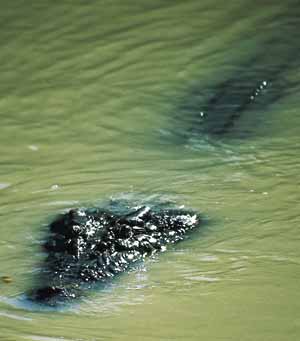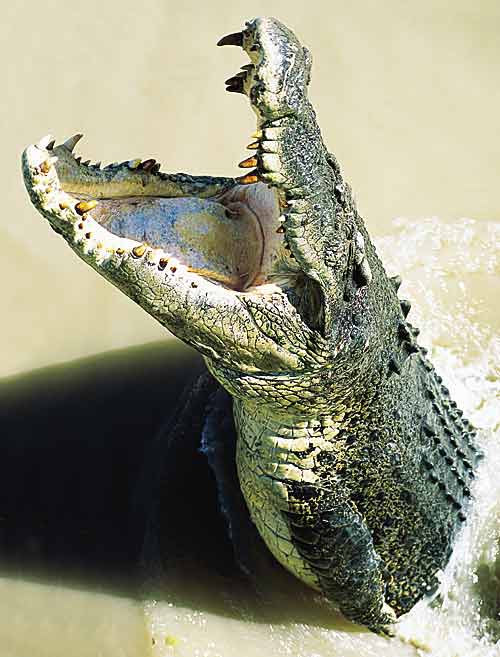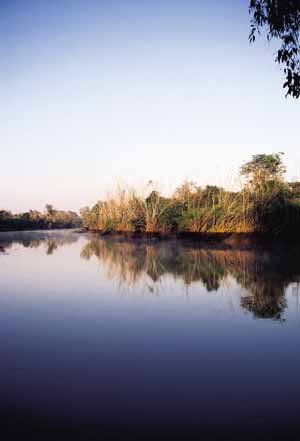Crocodiles come in different forms but they are pretty all the same, sharp teeth, ugly head, and pretty skin.
Of all the crocodilians including alligators, caimans, garial, false garial and crocodiles, Crocodylus Porosus is the largest. Where do they live? Right here in the land downunder. That's right; the saltwater or estuarine crocodiles, the world's largest, still calls Australia home.
We also have the freshwater crocodiles - Crocodylus Johnstoni - taken from the Johnstone river in Queensland where they were discovered. They are called freshies and are less aggressive than the estuarine croc. they feed primarily on fish and some small rodents. No! this does not mean you can walk up and pat them. They live in fresh water, rarely grow over three metres and are basically passive, when left alone. They are unlikely to stalk you, however, will bite if annoyed, threatened or if they have young.
I can hear you asking "what about the South and East Alligator Rivers?" American explorers, who didn't know the difference, discovered them. Quite frankly, our salties would open a can of whoop-ass on d'em gators.
Some older Territorians still refer to crocs, as gators - it sounds cool and easier to say - but you get what they mean. Saltwater crocs, salties, have glands in their bodies that disperse excess salt. This means that they can live in ANY water, which is why most Top Enders prefer showers.
 Towards the end of the 19th century , when white settlers arrived in the Top End, there where an estimated 100,000 salties in the waterways of the Northern Territory. Hunting crocs for skins became a major business, up to eight metres, were recorded. When croc hunting was halted in 1971 the numbers had dwindled to an estimated 10,000 or less as fears grew they be wiped out completely in some areas. After crocs were listed as 'A' Heritage in Australia, they were left alone, basically. Some scientists believe that an instinct of survival led crocs in some areas to breed twice, instead of the normal once a year, in an attempt to rebuild numbers. Today the numbers are estimated around 90,000 in the same areas. By the way, crocodiles don't bother with anything less than two metres because they might not survive.
Towards the end of the 19th century , when white settlers arrived in the Top End, there where an estimated 100,000 salties in the waterways of the Northern Territory. Hunting crocs for skins became a major business, up to eight metres, were recorded. When croc hunting was halted in 1971 the numbers had dwindled to an estimated 10,000 or less as fears grew they be wiped out completely in some areas. After crocs were listed as 'A' Heritage in Australia, they were left alone, basically. Some scientists believe that an instinct of survival led crocs in some areas to breed twice, instead of the normal once a year, in an attempt to rebuild numbers. Today the numbers are estimated around 90,000 in the same areas. By the way, crocodiles don't bother with anything less than two metres because they might not survive.
Conditions in the tropics are perfect for this dinosaur, warm water, ample food, room to move and no predators - except man. Today, any large croc, four metres or better, has survived the hunting period and is 30 to 40 years old. The correct way to age a croc is to saw its bones; they have growth rings like trees. Of course not all crocs were killed and the big fellas became very wary around humans, remebering the fire sticks they carry - boats mean death.
Crocodile farming has become an acceptable way to harvest the species. When larger crocs are caught in populated areas, they are taken to farms as breeding stock and also for show and tell. This is the safest way to see crocodiles up close.
With crocodiles back up to significant numbers, tourism has taken advantage of their presence; everyone wants to get closer to this survivor of the ages. The best way to do this is to feed them. The young ones are curious and have less fear of man, to them, boats mean food. As they get larger they will have less fear. Guess what will happen if a croc comes up to a boat expecting to get fed and you don't give him any?
Crocodiles Chronicles: Size DOES Matter
Larger crocs take a little longer to trust boats but the availability of a free feed is too much temptation. Take aggro for example, he lives in the Adelaide River, he is every bit of 5.5 metres, around 70 years of age and he gets fed by tour boats at least four times a day. He doesn't need to hunt; his belly is well catered for. If he can't be bothered eating, he will just give that evil look that says "rack off", turn his back and go under.
Hey Steve Irwin, crikey, he'd be fun to ride, eh? Go on bloke he's not hungry have a go. Just in case you are thinking gees that would be fun, eh? If he goes under I'll just hang on. Riding a death roll would be fun, if you could hang on. However, there is one small catch. Salties have a four-chamber heart, not unlike humans, except they have the ability to shut two of them down. This pushes oxygenated blood into the lungs; it also slows down the heart rate to as little as two beats per minute. A big croc can hold its breath for two hours or more. I bet you can't! As soon as you let go, you are in his territory, he can swim faster than you and hw will be angry.
If you think you can out run a croc on land, now hear this? A saltwater crocodile can exit the water at around 40kph, even if you see him coming, and you won't - by the time you have turned to run, he will have you by the back foot.
People want to see big crocs, tour guides want to feed big crocs. Seeing a saltie of four metres or better, leaping vertically out of the water is an amazing sight. Providing the water under them is deep enough they can get all four legs out of the water. This is particularly impressive if you are a tinny when you realise that a croc can jump over your boat and grab you on the way.
 Let's face it; old stinkers are not fussy if it breaths its food - birds, fish, pigs, cattle and people.
Let's face it; old stinkers are not fussy if it breaths its food - birds, fish, pigs, cattle and people.
Crocs have the ability to slow down their metabolic rate according to food supply. A croc of four metres can live on a chicken for two weeks if need be. Another thing is they don't chew their food; the teeth are designed to crush, hold and snap bones. With a closing pressure, up to 3,000psi they are capable of snapping the bones of anything that walks the earth.
Because they swallow their food whole they need to get a piece that fits down the throat. This is where the death roll comes in, grab hold, snap the bones and twist off a chunk and swallow.
Usually when a croc is approached by a boat it heads for the water. This is not because it's scared, at least not the big fellas. This is a croc's greatest advantage - stealth. From there it can see and hear everything you do.
Make no mistake, once a croc gets over four metres he is afraid of nothing, except a bigger croc. Salties get really big, five and six-metre males are not uncommon. Females rarely grow over three and a half metres.
Crocodiles have a certain mystique about them, which makes humans do stupid things. Swimming! I can't see any, it must be safe; it's not. This stealthiest of predators has all the time in the world, he will wait for days at a time, stalking, sniffing, feeling vibrations and assessing the situation. A croc can submerge and re-surface without so much as a ripple on the water. If you see fish scales on a riverbank in the middle of nowhere, it's probably been eaten by a croc. DO NOT SWIM HERE.
Common sense will tell you that a 'ridged-back mud gecko' will live near a food supply; I like seafood, so do they. Because they conserve as much energy as possible they live near food. If there are lots of barra or mud crabs you will find crocodiles near by.
Salties have multiple eyelids, both horizontal and vertical. They are a transparent film, which act like lenses so they can focus in varied conditions. They can see you on the bank from under the water.
When crocs hatch (they come from eggs) they have light and dark patches on their skin, the dark bits are like solar panels. Low tide in the morning on a mud bank is a good place to find crocs sunning themselves. Like all reptiles they are cold-blooded and need the sun to give them energy to hunt.
 As they get larger they get darker, absorbing more heat. They also camouflage themselves to their surroundings, dark water, dark skin. The biggest crocs are usually dark all over to almost black; a five or six-metre croc is huge and needs a lot of warmth to generate energy. It's hard to imagine a lizard of four metres or better. Go outside and measure your tinny, then imagine a reptile that is just as long and nearly as wide.
As they get larger they get darker, absorbing more heat. They also camouflage themselves to their surroundings, dark water, dark skin. The biggest crocs are usually dark all over to almost black; a five or six-metre croc is huge and needs a lot of warmth to generate energy. It's hard to imagine a lizard of four metres or better. Go outside and measure your tinny, then imagine a reptile that is just as long and nearly as wide.
A five-metre croc can weigh in at 600kg, a six metre around 900kg, this is almost a tonne. Like people, when they get to a certain age they spread in all directions, like me! Consider this if you are thinking of taking one home to show the kiddies.
Crocs are often seen on the banks with mouth open. Once they reach operating temperature they open their massive jaws to allow cooling of the brain. In the cooler times, the long cold week of winter, July 7-15, where night temperatures drop to a bone chilling 12 degrees Celsius, they are sluggish. During cool weather, sometimes, they prefer to remain out of the water whenever possible. This does not mean that you can go swimming in winter - it's too bloody cold. Despite the usual warmth of the tropics it gets quite cold on some mornings, a foggy river-bank is very pretty and it is also very deceptive. The water can often be warmer than the ambient temperature. In this case guess where the crocs will be?
In summer when everything is warm, they are most active. So are the fish. Hence, good fishing for you, good for crocs. It's also mating season.
I used to think that crocs, being air breathers could not attack underwater, pulling up half a barra one day made me rethink this theory. Watching crocodiles feed at close range I learned that they have a flap in their throats, which stops water coming in. However, they must have their head out of the water to swallow or they drown.
Crocodiles have really bad breath - they never brush their teeth - something to do with the size of their legs. Many of the crocodile hunters who survived attacks died from the infection that usually followed.
Strangely enough, crocodiles have the ability to shut down the blood flow to a missing limb or tail lost in a fight. And they never get infections themselves. Apparently scientists have isolated the gene responsible for this and are currently researching ways to adapt it to humans.
Crocodiles are amphibians, they can walk across land as well as you and me and can move very fast over a short distance. They also like to hide in the shade and sneak through the grass, which they can do without a sound.
Living with crocodiles can be a major learning curve.


